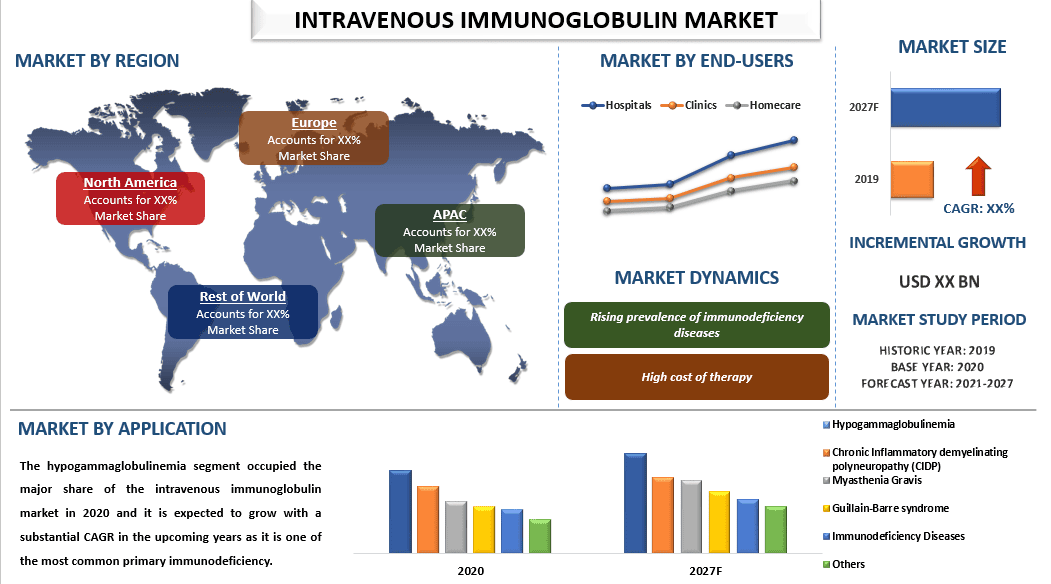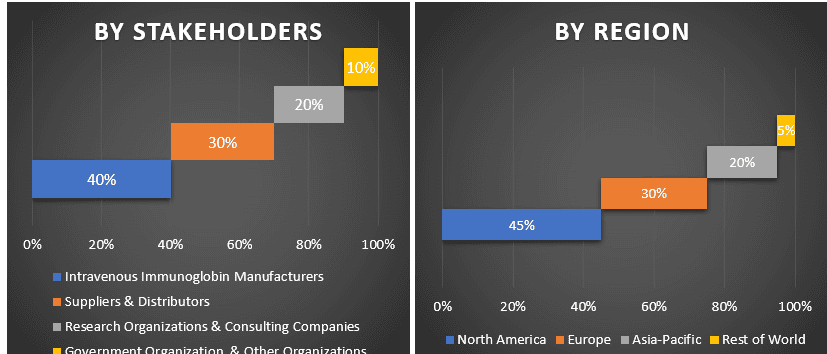- Home
- About Us
- Industry
- Services
- Reading
- Contact Us
Intravenous Immunoglobulin Market: Current Analysis and Forecast (2021-2027)
Emphasis on Product (IgG, IgE, IgA, IgD, IgM); Application (Hypogammaglobulinemia, Cidp, Myasthenia Gravis, Guillain-Barre Syndrome, Immunodeficiency Diseases, Others); End-Users (Hospitals, Clinics, Homecare); Region/Country

Global Intravenous Immunoglobulin Market is anticipated to grow with an elevated CAGR of around 7% over the forecast period (2021-2027). Glycoprotein molecules that are manufactured by the plasma or the white blood cells are known as immunoglobulins. These immunoglobulins that are administered through the intravenous route are intravenous immunoglobulins. The growing adoption of intravenous immunoglobulin can be attributed to the rising prevalence of various immunodeficiency diseases coupled with a rapidly growing geriatric population. According to the United Nations, the 60+ aged population was 962 million in 2017 which is more than twice that it was in 1980 at 382 million. The number of elderly people is expected to double again by 2050 and reach nearly 2.1 billion worldwide. Furthermore, with rapid advancements in technology, many of the industry players are focusing on launching new products leading to expedited FDA approvals which in turn will drive the market for intravenous immunoglobulin globally. For example, in February 2021, Pfizer Inc. announced that the U.S. Food and Drug Administration (FDA) has approved the supplemental Biologics License Application (sBLA) for PANZYGA (Immune Globulin Intravenous [Human] – ifas 10% Liquid Preparation) to treat adult patients with a rare neurological disease of the peripheral nerves called chronic inflammatory demyelinating polyneuropathy (CIDP).
Biotest AG, Baxter International Inc., Octapharma AG, China Biologic Products, Inc., CSL Behring LLC, Grifols S.A., Kedrion S.p.A., Pfizer Inc., LFB Biomedicaments S.A., Baxalta, are some of the prominent players operating in the intravenous immunoglobulin market. Several M&As along with partnerships have been undertaken by these players to facilitate customers with Intravenous Immunoglobulin.
Insights Presented in the Report
“Amongst Product, IgG segment holds the major share”
Based on the product, the intravenous immunoglobulin market is segmented into IgG, IgE, IgA, IgD, and IgM. The IgG segment accounted for a significant market share in 2020 and it is estimated that it will grow rapidly during the projected timeframe as it is the most common antibody (75% to 80%) of all antibodies present in our body that are required for fighting various viral and bacterial infections.
“Amongst Application, hypogammaglobulinemia segment holds the major share”
Based on application, the Intravenous Immunoglobulin market is divided into hypogammaglobulinemia, CIDP, myasthenia gravis, Guillain-barre syndrome, immunodeficiency diseases, and others. The hypogammaglobulinemia segment occupied the major share of the intravenous immunoglobulin market in 2020 and it is expected to grow with a substantial CAGR in the upcoming years as it is one of the most common primary immunodeficiency which encompasses a majority of immune-compromised patients. However, the CIDP segment is also expected to grow considerably during the upcoming years.
“Amongst End-Users, hospitals segment holds the major share”
Based on end-users, the market is fragmented into hospitals, clinics, and homecare. In 2020, the hospitals segment grabbed a considerable market share, and it is expected to grow at a significant CAGR during the forecast period owing to the increasing number of hospitals and growing adoption of intravenous immunoglobulin products in hospitals. Also, the presence of well-trained healthcare professionals, well-established infrastructure, and ease of time-to-time monitoring of patients in hospitals are some of the factors contributing to the growth of this segment. However, clinics are also likely to witness lucrative growth during the forecast period.
“North America represents one of the largest markets of intravenous immunoglobulin market”
For a better understanding of the market dynamics of the intravenous immunoglobulin market, a detailed analysis was conducted for different regions across the globe including North America (the U.S, Canada, and the Rest of North America), Europe (Germany, France, Spain, United Kingdom, Italy, and Rest of Europe), Asia-Pacific (China, India, Australia, Japan, and Rest of APAC), Rest of World has been conducted. North America constitutes a major market for the intravenous immunoglobulin market industry in 2020 owing to strong healthcare infrastructure and growing adoption of intravenous immunoglobulin therapies in the region.
Reasons to buy this report:
- The study includes market sizing and forecasting analysis validated by authenticated key industry experts
- The report presents a quick review of overall industry performance at one glance
- The report covers an in-depth analysis of prominent industry peers with a primary focus on key business financials, product portfolio, expansion strategies, and recent developments
- Detailed examination of drivers, restraints, key trends, and opportunities prevailing in the industry
- The study comprehensively covers the market across different segments
- Deep dive regional level analysis of the industry
Customization Options:
The global intravenous immunoglobulin market can further be customized as per the requirement or any other market segment. Besides this, UMI understands that you may have your own business needs, hence feel free to connect with us to get a report that completely suits your requirements.
Table of Content
Research Methodology for the Global Intravenous Immunoglobulin Market Analysis (2021-2027)
Analyzing the historical market, estimation of the current market, and forecasting the future market of the global intravenous immunoglobulin market were the three major steps undertaken to create and analyze the adoption of intravenous immunoglobulin in major regions globally. Exhaustive secondary research was conducted to collect the historical market numbers and estimate the current market size. Secondly, to validate these insights, numerous findings and assumptions were taken into consideration. Moreover, exhaustive primary interviews were also conducted, with industry experts across the value chain of the global intravenous immunoglobulin market. Post assumption and validation of market numbers through primary interviews, we employed a top-down/bottom-up approach to forecasting the complete market size. Thereafter, market breakdown and data triangulation methods were adopted to estimate and analyze the market size of segments and sub-segments the industry pertains to. Detailed methodology is explained below:
Seek More Details About Research Methodology
Analysis of Historical Market Size
Step 1: In-Depth Study of Secondary Sources:
Detail secondary study was conducted to obtain the historical market size of intravenous immunoglobulin through company internal sources such as annual report & financial statements, performance presentations, press releases, etc., and external sources including journals, news & articles, government publications, competitor publications, sector reports, third-party database, and other credible publications.
Step 2: Market Segmentation:
After obtaining the historical market size of the intravenous immunoglobulin market, we conducted a detailed secondary analysis to gather historical market insights and share for different segments & sub-segments for major regions. Major segments included in the report as product, applications, and end-users. Further country-level analyses were conducted to evaluate the overall adoption of Intravenous Immunoglobulin across the globe.
Step 3: Factor Analysis:
After acquiring the historical market size of different segments and sub-segments, we conducted a detailed factor analysis to estimate the current market size of the intravenous immunoglobulin. Further, we conducted factor analysis using dependent and independent variables such as type, application, and end-users. A thorough analysis was conducted for demand and supply-side scenarios considering top partnerships, merger and acquisition, business expansion, and product launches in the Intravenous Immunoglobulin sector across the globe.
Current Market Size Estimate & Forecast
Current Market Sizing: Based on actionable insights from the above 3 steps, we arrived at the current market size, key players in the intravenous immunoglobulin market, and market shares of the segments. All the required percentage shares split, and market breakdowns were determined using the above-mentioned secondary approach and were verified through primary interviews.
Estimation & Forecasting: For market estimation and forecast, weights were assigned to different factors including drivers & trends, restraints, and opportunities available for the stakeholders. After analyzing these factors, relevant forecasting techniques i.e., top-down/bottom-up approach was applied to arrive at the market forecast about 2027 for different segments and subsegments across the major markets globally. The research methodology adopted to estimate the market size encompasses:
- The industry’s market size, in terms of value (US$) and the adoption rate of intravenous immunoglobulin across the major markets domestically
- All percentage shares, splits, and breakdowns of market segments and sub-segments
- Key players in the intravenous immunoglobulin market in terms of products offered. Also, the growth strategies adopted by these players to compete in the fast-growing market
Market Size and Share Validation
Primary Research: In-depth interviews were conducted with the Key Opinion Leaders (KOLs) including Top Level Executives (CXO/VPs, Sales Head, Marketing Head, Operational Head, and Regional Head, Country Head, etc.) across major regions. Primary research findings were then summarized, and statistical analysis was performed to prove the stated hypothesis. Inputs from primary research were consolidated with secondary findings, hence turning information into actionable insights.
Split of Primary Participants in Different Regions

Market Engineering
Data triangulation technique was employed to complete the overall market estimation and to arrive at precise statistical numbers of each segment and sub-segment of the intravenous immunoglobulin market. Data was split into several segments & sub-segments post studying various parameters and trends in the areas of type, application, and end-users of the intravenous immunoglobulin market.
The main objective of the Intravenous Immunoglobulin Market Study
The current & future market trends of intravenous immunoglobulin were pinpointed in the study. Investors can gain strategic insights to base their discretion for investments from the qualitative and quantitative analysis performed in the study. Current and future market trends were determined the overall attractiveness of the market at a regional level, providing a platform for the industrial participant to exploit the untapped market to benefit as a first-mover advantage. Other quantitative goals of the studies include:
- Analyze the current and forecast market size of intravenous immunoglobulin in terms of value (US$). Also, analyze the current and forecast market size of different segments and sub-segments
- Segments in the study include areas of product, application, and end-users
- Define and analysis of the regulatory framework for the intravenous immunoglobulin industry
- Analyze the value chain involved with the presence of various intermediaries, along with analyzing customer and competitor behaviors of the industry
- Analyze the current and forecast market size of the intravenous immunoglobulin market for the major region
- Major regions studied in the report include North America, Europe, Asia-Pacific and Rest of the world
- Company profiles of the intravenous immunoglobulin market and the growth strategies adopted by the market players to sustain in the fast-growing market
- Deep dive regional level analysis of the industry
Related Reports
Customers who bought this item also bought










